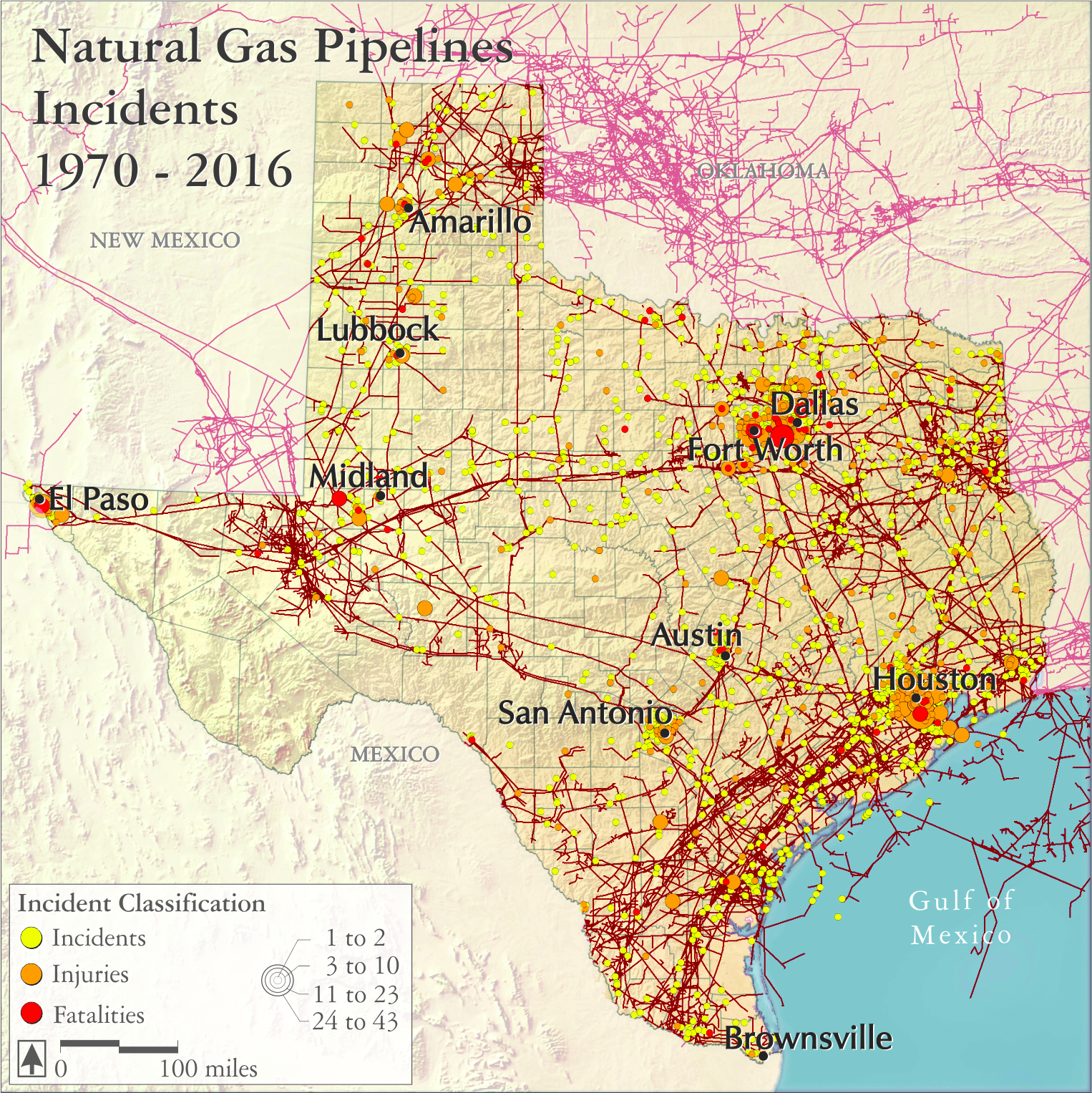
Natural Gas Pipelines
Natural gas is a versatile feedstock for plastics and other chemicals, and a valuable bridge fuel to a low-carbon economy. However, the network for compressing, moving, and storing the gas is vast (the Texas transmission and distribution lines measure over 70,600 miles in length), and its operation is complex and dangerous (U.S. DOT 2016).
From 1970 through 2016, over 4000 accidents (as shown in this map) have occurred in Texas natural gas gathering, transmission and distribution lines due to excavation, corrosion, mechanical failure, control system issues, as well as natural forces, such as floods. During this 47-year period, 110 people have lost their lives in gas pipeline accidents, 711 have suffered injuries and $203 million in property losses have been recorded in the state (PHMSA 2016; USEIA 2016).
While pipelines are estimated to be 40 times safer than rail tanks, and 100 times safer than road tanks, the pipeline system is aging and these older facilities are becoming more vulnerable (Hopkins 2007, pp. 3, 19). Forty six percent of Texas gas transmission and distribution lines, by mileage, were installed before 1970, and the age of equipment suffering leaks is increasing (Groeger 2012, p. 2; PHMSA 2016; U.S. DOT 2016).
Sources:
Groeger, Lena. 2012. Pipelines Explained: How Safe are America’s 2.5 Million Miles of Pipelines. ProPublica. November 15, 2012.
Hopkins, P. 2007. Pipelines: Past, Present, and Future. 5th Asian Pacific IIW International Congress, Sydney Australia. March 7-9, 2007.
Parformak, Paul. 2013. Keeping America’s Pipelines Safe and Secure: Key Issues for Congress. Congressional Research Service. January 9, 2013.
PHMSA. 2016. Distribution, Transmission & Gathering, LNG, and Liquid Accident and Incident Data. Pipeline and Hazardous Materials Safety Administration, U.S. Department of Transportation. http://www.phmsa.dot.gov/pipeline/library/data-stats/distribution-transmission-and-gathering-lng-and-liquid-accident-and-incident-data, accessed November 18, 2016.
Texas Railroad Commission. 2016. Accident and Incident Reporting. http://www.rrc.state.tx.us/pipeline-safety/enforcement/accidentincident-reporting/, accessed November 17, 2016.
U.S. DOT. 2016. Gas Distribution and Transmission Pre-1970 and Unknown Decades. U.S. Department of Transportation, Pipeline and Hazardous Materials Safety Administration. https://hip.phmsa.dot.gov/analyticsSOAP/saw.dll?PortalPages, accessed November 17, 2016.
U.S. EIA. 2016. Maps: Layer Information for Interactive State Maps: Natural Gas Interstate and Intrastate Pipelines. U.S. Energy Information Administration. https://www.eia.gov/maps/layer_info-m.php, accessed November 17, 2016.
U.S. EPA. 2016. Inventory of U.S. Greenhouse Gas Emissions and Sinks: 1990-2014. U.S. Environmental Protection Agency. Washington, D.C. April 15, 2016.
